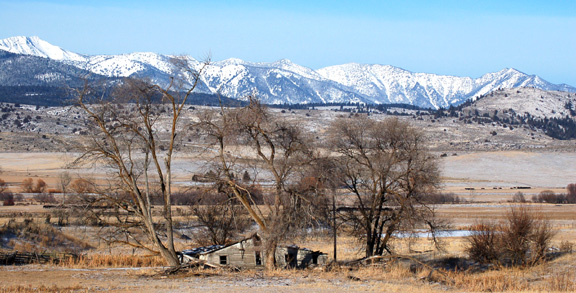Friday, June 4, 2010
Oregon Judge Rules the Forest Service’s grazing plan allowed livestock to damage critical habitat for steelhead.
___
This is a case that I am intimately familiar with.
From ONDA
A federal judge ruled today that livestock grazing has degraded important native steelhead streams on nearly a half-million acres of public land on the Malheur National Forest. Judge Ancer Haggerty found that the Forest Service’s grazing plan allowed livestock to damage critical habitat for steelhead along more than 300 miles of streams in the John Day River Basin. This ruling marks the latest in a string of successes against the agency by the Oregon Natural Desert Association (ONDA), Center for Biological Diversity and Western Watersheds Project, who have been challenging Malheur forest grazing since 2003.
According to evidence gathered by the conservation groups, as well as the agency’s own surveys, stream side grazing permitted by the Forest Service has caused failures to meet ecological standards meant to conserve steelhead. The standards, established by the Forest Service and the National Marine Fisheries Service (NMFS), are meant to protect the key elements of healthy fish streams: stable stream banks and overhanging vegetation that keep streams clear and cold. Evidence showed the Forest Service’s grazing program resulted in damaged stream banks many times worse than the amount allowed under the federal standards.
“Recognizing that endangered fish like steelhead trout can’t survive if the places where they live are destroyed, the Endangered Species Act includes strong provisions to protect habitat,” said Brent Fenty, ONDA’s Executive Director. “The court’s decision upholding the protections of the Act is good both for steelhead and for the streams they live in.”
The judge specifically criticized the Forest Service’s failure to prevent “inordinate” damage in several areas the agency admitted were particularly important to the steelhead’s ability to avoid extinction, as well as the agency’s “empty promises” and reliance on a plan that lacked mandatory monitoring and enforcement measures. The judge also ruled that the Forest Service failed to properly consult with the fisheries agency about the grazing plan, as is required by federal law. The Forest Service failed to measure and evaluate stream conditions before authorizing grazing during the last three years.
This is the first ruling on the merits in the decade-long litigation targeting pervasive damage from Forest Service authorized grazing. The steelhead, an iconic Pacific Northwest native trout, is listed under the Endangered Species Act as a “threatened” species in danger of extinction.
“We want to see steelhead recover in the John Day so they can once again be a central social, cultural and economic asset to people in the Basin and to all Oregonians,” said Fenty. “Today’s decision guarantees long-term improvements in the Forest Service’s management of these sensitive streams.”
Earlier this week, the conservation groups agreed with the Forest Service and grazing permittees to allow reduced grazing during 2010 coupled with strict protections to insure that cattle do not damage steelhead critical habitat. In conjunction with today’s court decision, the agreement puts the onus on the Forest Service and permittees to insure that livestock do not damage steelhead streams.
Over the past two years, Judge Haggerty has issued two preliminary rulings in this case which have resulted in significant protections for threatened steelhead. In 2008, the court issued an injunction barring grazing on two allotments. That ruling protected over 90 miles of steelhead streams. In the places where the court’s orders have prevented grazing during the past two years, even a single year of rest already has allowed for significant initial recovery of riparian plant communities, stream channels, and fish habitat to begin.
The Malheur National Forest is located in eastern Oregon’s Blue Mountains. It includes portions of the Upper John Day, Middle Fork John Day, North Fork John Day, and Malheur Rivers. The 281-mile long John Day River is the second longest undammed river in the continental United States. The river and its hundreds of miles of tributary streams on the Malheur National Forest provide spawning, rearing and migratory habitat for the largest naturally spawning, native stock of wild steelhead remaining in the Columbia River Basin.
This is a case that I am intimately familiar with.
From ONDA
A federal judge ruled today that livestock grazing has degraded important native steelhead streams on nearly a half-million acres of public land on the Malheur National Forest. Judge Ancer Haggerty found that the Forest Service’s grazing plan allowed livestock to damage critical habitat for steelhead along more than 300 miles of streams in the John Day River Basin. This ruling marks the latest in a string of successes against the agency by the Oregon Natural Desert Association (ONDA), Center for Biological Diversity and Western Watersheds Project, who have been challenging Malheur forest grazing since 2003.
According to evidence gathered by the conservation groups, as well as the agency’s own surveys, stream side grazing permitted by the Forest Service has caused failures to meet ecological standards meant to conserve steelhead. The standards, established by the Forest Service and the National Marine Fisheries Service (NMFS), are meant to protect the key elements of healthy fish streams: stable stream banks and overhanging vegetation that keep streams clear and cold. Evidence showed the Forest Service’s grazing program resulted in damaged stream banks many times worse than the amount allowed under the federal standards.
“Recognizing that endangered fish like steelhead trout can’t survive if the places where they live are destroyed, the Endangered Species Act includes strong provisions to protect habitat,” said Brent Fenty, ONDA’s Executive Director. “The court’s decision upholding the protections of the Act is good both for steelhead and for the streams they live in.”
The judge specifically criticized the Forest Service’s failure to prevent “inordinate” damage in several areas the agency admitted were particularly important to the steelhead’s ability to avoid extinction, as well as the agency’s “empty promises” and reliance on a plan that lacked mandatory monitoring and enforcement measures. The judge also ruled that the Forest Service failed to properly consult with the fisheries agency about the grazing plan, as is required by federal law. The Forest Service failed to measure and evaluate stream conditions before authorizing grazing during the last three years.
This is the first ruling on the merits in the decade-long litigation targeting pervasive damage from Forest Service authorized grazing. The steelhead, an iconic Pacific Northwest native trout, is listed under the Endangered Species Act as a “threatened” species in danger of extinction.
“We want to see steelhead recover in the John Day so they can once again be a central social, cultural and economic asset to people in the Basin and to all Oregonians,” said Fenty. “Today’s decision guarantees long-term improvements in the Forest Service’s management of these sensitive streams.”
Earlier this week, the conservation groups agreed with the Forest Service and grazing permittees to allow reduced grazing during 2010 coupled with strict protections to insure that cattle do not damage steelhead critical habitat. In conjunction with today’s court decision, the agreement puts the onus on the Forest Service and permittees to insure that livestock do not damage steelhead streams.
Over the past two years, Judge Haggerty has issued two preliminary rulings in this case which have resulted in significant protections for threatened steelhead. In 2008, the court issued an injunction barring grazing on two allotments. That ruling protected over 90 miles of steelhead streams. In the places where the court’s orders have prevented grazing during the past two years, even a single year of rest already has allowed for significant initial recovery of riparian plant communities, stream channels, and fish habitat to begin.
The Malheur National Forest is located in eastern Oregon’s Blue Mountains. It includes portions of the Upper John Day, Middle Fork John Day, North Fork John Day, and Malheur Rivers. The 281-mile long John Day River is the second longest undammed river in the continental United States. The river and its hundreds of miles of tributary streams on the Malheur National Forest provide spawning, rearing and migratory habitat for the largest naturally spawning, native stock of wild steelhead remaining in the Columbia River Basin.











